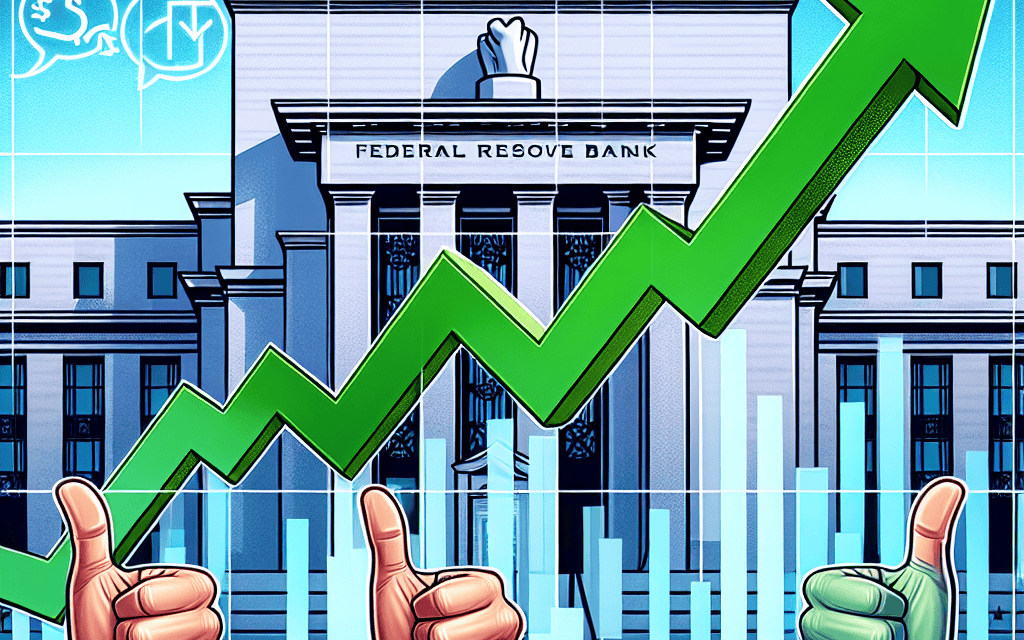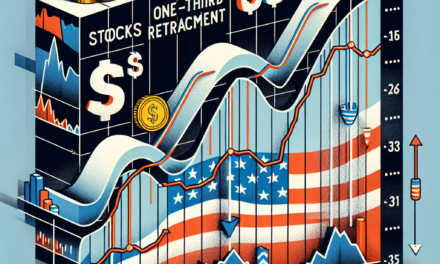“Markets Surge: Inflation Eases, Paving Way for Potential Fed Rate Cut”
Introduction
In a promising turn for investors, the stock market witnessed a notable upswing as the Dow Jones Industrial Average, S&P 500, and Nasdaq Composite all posted gains. This positive momentum was largely driven by encouraging inflation data, which has bolstered hopes for a potential interest rate cut by the Federal Reserve. The latest economic indicators suggest a cooling in inflationary pressures, providing a favorable backdrop for equities and enhancing market sentiment. As investors digest this data, the anticipation of a more accommodative monetary policy stance by the Fed is fueling optimism across the financial markets, contributing to the upward trajectory of major stock indices.
Impact Of Positive Inflation Data On Stock Market Indices
The recent release of positive inflation data has provided a significant boost to major stock market indices, including the Dow Jones Industrial Average, the S&P 500, and the Nasdaq Composite. This development has sparked optimism among investors, as it suggests a potential shift in the Federal Reserve’s monetary policy, specifically regarding interest rate cuts. As inflationary pressures appear to be easing, market participants are increasingly hopeful that the Federal Reserve will adopt a more accommodative stance, which could further stimulate economic growth and enhance corporate profitability.
To begin with, the Dow Jones Industrial Average, a key barometer of the U.S. stock market, has experienced a notable uptick. This index, which comprises 30 prominent companies, is often viewed as a reflection of the broader economic landscape. The positive inflation data has alleviated some of the concerns that have been weighing on the market, such as the potential for prolonged high inflation and its impact on consumer spending. As a result, investors have shown renewed confidence in the economic outlook, driving the Dow higher.
Similarly, the S&P 500, which represents a broader spectrum of the market with its inclusion of 500 large-cap companies, has also benefited from the favorable inflation report. The easing of inflationary pressures is particularly significant for this index, as it encompasses a diverse range of sectors, including technology, healthcare, and consumer goods. Lower inflation can lead to reduced input costs for companies, thereby improving profit margins. Consequently, the S&P 500 has seen gains as investors anticipate stronger earnings growth in the coming quarters.
Moreover, the Nasdaq Composite, heavily weighted towards technology and growth-oriented stocks, has experienced a surge in response to the inflation data. Technology companies, which often rely on borrowing to finance their expansion, stand to benefit from lower interest rates. The prospect of a Federal Reserve rate cut could reduce borrowing costs, making it more attractive for these companies to invest in innovation and development. This has led to increased investor interest in the tech sector, propelling the Nasdaq to new heights.
In addition to the direct impact on stock market indices, the positive inflation data has broader implications for the economy. Lower inflation can enhance consumer purchasing power, as individuals and households face less pressure from rising prices. This, in turn, can boost consumer spending, a critical driver of economic growth. As consumer confidence strengthens, businesses may experience increased demand for their products and services, further supporting the upward momentum in stock prices.
Furthermore, the potential for a Federal Reserve rate cut has implications for the bond market. Lower interest rates typically lead to higher bond prices, as existing bonds with higher yields become more attractive to investors. This dynamic can create a favorable environment for both equity and fixed-income markets, as investors seek to balance their portfolios in response to changing economic conditions.
In conclusion, the release of positive inflation data has had a profound impact on major stock market indices, including the Dow Jones Industrial Average, the S&P 500, and the Nasdaq Composite. The prospect of a Federal Reserve rate cut has fueled investor optimism, driving gains across various sectors. As inflationary pressures ease, the potential for enhanced economic growth and corporate profitability becomes more pronounced, providing a favorable backdrop for continued market strength. As always, investors will closely monitor future economic indicators and Federal Reserve actions to assess the sustainability of this positive trend.
Federal Reserve Rate Cut: Implications For Dow, S&P 500, And Nasdaq
The recent surge in the stock market, marked by notable gains in the Dow Jones Industrial Average, the S&P 500, and the Nasdaq Composite, can be attributed to the release of positive inflation data, which has bolstered investor confidence in the possibility of a Federal Reserve rate cut. This development has significant implications for the financial markets, as it suggests a potential shift in monetary policy that could influence investment strategies and economic growth.
The latest inflation figures indicate a deceleration in price increases, providing a sense of relief to both investors and policymakers who have been concerned about the persistent inflationary pressures over the past year. This slowdown in inflation is seen as a key factor that could prompt the Federal Reserve to consider easing its monetary policy stance. Historically, lower interest rates have been associated with increased borrowing and spending, which can stimulate economic activity and, in turn, support higher stock prices.
As investors digest this data, the anticipation of a rate cut has led to a rally in the stock market. The Dow Jones Industrial Average, a key indicator of the overall health of the stock market, has experienced a significant uptick, reflecting investor optimism. Similarly, the S&P 500, which represents a broader swath of the market, has also climbed, underscoring the widespread positive sentiment. Meanwhile, the tech-heavy Nasdaq Composite has seen gains as well, driven by the prospect of lower borrowing costs benefiting technology companies that often rely on external financing for growth.
The potential for a Federal Reserve rate cut not only impacts stock prices but also has broader economic implications. Lower interest rates can reduce the cost of capital for businesses, encouraging investment in new projects and expansion efforts. This can lead to job creation and increased consumer spending, further fueling economic growth. Additionally, a rate cut can alleviate some of the financial pressures on consumers, making it more affordable to finance large purchases such as homes and cars.
However, it is important to consider the potential risks associated with a rate cut. While lower rates can stimulate economic activity, they can also lead to asset bubbles if investors become overly exuberant. Moreover, if inflationary pressures resurface, the Federal Reserve may find itself in a challenging position, needing to balance economic growth with price stability.
In light of these considerations, market participants are closely monitoring the Federal Reserve’s communications for any indications of its future policy direction. The central bank’s decisions will likely be influenced by a range of economic indicators, including employment data, consumer spending patterns, and global economic conditions. As such, investors are advised to remain vigilant and consider the potential implications of monetary policy changes on their portfolios.
In conclusion, the recent climb in the Dow, S&P 500, and Nasdaq amid positive inflation data highlights the complex interplay between economic indicators and market dynamics. The prospect of a Federal Reserve rate cut has injected optimism into the financial markets, with potential benefits for economic growth and investment. However, investors must remain mindful of the broader economic context and the potential risks associated with changes in monetary policy. As the situation evolves, staying informed and adaptable will be key to navigating the opportunities and challenges that lie ahead.
Analyzing The Climb Of Major Indices Amid Economic Shifts
The recent performance of major stock indices, including the Dow Jones Industrial Average, the S&P 500, and the Nasdaq Composite, has captured the attention of investors and analysts alike. This upward trajectory can be attributed to a confluence of factors, most notably the release of positive inflation data that has bolstered hopes for a potential interest rate cut by the Federal Reserve. As these indices climb, it is essential to understand the underlying economic shifts that are influencing market sentiment and driving investment decisions.
To begin with, the latest inflation figures have provided a sense of relief to market participants who have been closely monitoring price stability. The data indicates a deceleration in inflationary pressures, suggesting that the aggressive monetary tightening measures implemented by the Federal Reserve over the past year are beginning to yield results. This development has sparked optimism that the central bank may soon pivot towards a more accommodative monetary policy stance, potentially reducing interest rates to support economic growth. Consequently, investors have responded positively, driving up stock prices across various sectors.
Moreover, the anticipation of a rate cut has had a pronounced impact on investor behavior, as lower interest rates generally enhance the attractiveness of equities relative to fixed-income securities. With borrowing costs potentially decreasing, companies may find it easier to finance expansion projects, thereby boosting their growth prospects. This expectation has led to increased buying activity, particularly in growth-oriented sectors such as technology and consumer discretionary, which are well-represented in the Nasdaq Composite. As a result, the index has experienced notable gains, reflecting investor confidence in the future earnings potential of these companies.
In addition to the favorable inflation data, other economic indicators have also contributed to the positive market sentiment. For instance, recent employment reports have shown a robust labor market, with steady job creation and low unemployment rates. This strength in the labor market suggests that consumer spending, a critical driver of economic growth, is likely to remain resilient. As consumer confidence remains high, businesses are expected to benefit from sustained demand for goods and services, further supporting stock valuations.
Furthermore, geopolitical developments have played a role in shaping market dynamics. Recent progress in trade negotiations between major economies has alleviated some of the uncertainties that have weighed on global markets in recent years. The prospect of reduced trade tensions has been welcomed by investors, as it diminishes the risk of supply chain disruptions and fosters a more stable environment for international commerce. This improved outlook has contributed to the overall bullish sentiment, encouraging investors to allocate capital to equities.
While the current market environment appears favorable, it is important to acknowledge potential risks that could temper the optimism. For instance, any unexpected resurgence in inflation or a deterioration in economic indicators could prompt the Federal Reserve to reassess its policy trajectory. Additionally, geopolitical tensions or unforeseen global events could introduce volatility and disrupt the upward momentum of the indices. Therefore, investors should remain vigilant and consider a diversified approach to managing their portfolios.
In conclusion, the recent climb of the Dow Jones Industrial Average, the S&P 500, and the Nasdaq Composite can be attributed to a combination of positive inflation data, expectations of a Federal Reserve rate cut, and encouraging economic indicators. As these factors continue to influence market sentiment, investors are advised to stay informed and adaptable in navigating the evolving economic landscape.
Investor Sentiment: How Inflation Data Influences Market Trends

Investor sentiment plays a crucial role in shaping market trends, and recent developments in inflation data have provided a significant boost to the stock market. The Dow Jones Industrial Average, S&P 500, and Nasdaq Composite have all experienced notable gains, driven by optimism surrounding the potential for a Federal Reserve rate cut. This positive momentum can be attributed to the latest inflation figures, which suggest a cooling in price pressures, thereby alleviating concerns about prolonged inflationary trends.
To understand the impact of inflation data on investor sentiment, it is essential to consider the broader economic context. Inflation, the rate at which the general level of prices for goods and services rises, erodes purchasing power and can lead to higher interest rates as central banks attempt to curb excessive price increases. In recent months, inflation has been a focal point for investors, with fears that persistent inflation could prompt the Federal Reserve to maintain or even increase interest rates. However, the latest data indicates a moderation in inflationary pressures, providing a sense of relief to market participants.
The recent inflation report revealed that both the Consumer Price Index (CPI) and the Producer Price Index (PPI) have shown signs of stabilization. This development is significant because it suggests that the aggressive monetary tightening measures implemented by the Federal Reserve may be yielding the desired effect of tempering inflation. As a result, investors are increasingly optimistic that the central bank might consider a rate cut in the near future, which would lower borrowing costs and potentially stimulate economic activity.
This optimism is reflected in the performance of major stock indices. The Dow Jones Industrial Average has climbed steadily, buoyed by gains in sectors such as technology, consumer goods, and financials. Similarly, the S&P 500 has seen a broad-based rally, with many of its constituent companies reporting strong earnings and positive forward guidance. The Nasdaq Composite, heavily weighted towards technology stocks, has also experienced a surge, driven by investor confidence in the growth prospects of tech giants.
Moreover, the prospect of a rate cut has implications beyond the immediate stock market gains. Lower interest rates generally lead to a more favorable borrowing environment, encouraging businesses to invest in expansion and consumers to increase spending. This, in turn, can lead to higher corporate profits and economic growth, further bolstering investor confidence. Additionally, a rate cut could weaken the U.S. dollar, making American exports more competitive on the global stage and potentially improving the trade balance.
However, it is important to note that while the current inflation data has been encouraging, uncertainties remain. Geopolitical tensions, supply chain disruptions, and potential shifts in consumer behavior could still pose challenges to the economic outlook. Investors must remain vigilant and consider these factors when making investment decisions.
In conclusion, the recent positive inflation data has significantly influenced investor sentiment, leading to gains in the Dow, S&P 500, and Nasdaq. The anticipation of a potential Federal Reserve rate cut has further fueled this optimism, as market participants look forward to a more accommodative monetary policy environment. While challenges persist, the current market trends underscore the importance of inflation data in shaping investor expectations and driving stock market performance. As always, investors should stay informed and consider a range of factors when navigating the ever-evolving financial landscape.
The Role Of Inflation In Shaping Federal Reserve Policies
Inflation plays a pivotal role in shaping the monetary policies of the Federal Reserve, influencing decisions that have far-reaching implications for the economy. Recently, the stock market has responded positively to new inflation data, with the Dow, S&P 500, and Nasdaq all experiencing gains. This uptick is largely attributed to the anticipation of a potential rate cut by the Federal Reserve, a move that investors believe could be on the horizon given the current economic indicators.
To understand the connection between inflation and Federal Reserve policies, it is essential to recognize that the Federal Reserve, or the Fed, uses interest rates as a primary tool to manage economic stability. When inflation is high, the Fed typically raises interest rates to cool down the economy, making borrowing more expensive and saving more attractive. Conversely, when inflation is low, the Fed may lower interest rates to stimulate economic activity by encouraging borrowing and investment.
The recent inflation data suggests a moderation in price increases, which has been interpreted by many as a sign that the Fed might consider easing its monetary policy. This potential shift is significant because lower interest rates generally lead to increased consumer spending and business investment, both of which are beneficial for economic growth. Consequently, the stock market often reacts favorably to the prospect of rate cuts, as they can enhance corporate profitability and boost stock valuations.
Moreover, the relationship between inflation and Federal Reserve policies is not just about numbers; it also involves managing expectations. The Fed’s communication strategy plays a crucial role in shaping market perceptions. By signaling its intentions regarding interest rates, the Fed can influence investor behavior even before any actual policy changes occur. In this context, the recent positive inflation data has fueled speculation that the Fed might adopt a more accommodative stance, thereby bolstering market confidence.
However, it is important to note that the Fed’s decision-making process is complex and multifaceted. While inflation is a key factor, the Fed also considers other economic indicators such as employment levels, GDP growth, and global economic conditions. Therefore, while the current inflation data supports the case for a rate cut, the Fed will likely weigh this against other economic variables before making a definitive decision.
In addition, the Fed’s dual mandate of promoting maximum employment and stable prices means that it must balance these sometimes competing objectives. While low inflation might suggest room for a rate cut, the Fed must also ensure that such a move does not lead to overheating in other parts of the economy. This delicate balancing act underscores the complexity of monetary policy and the challenges faced by policymakers in navigating an ever-changing economic landscape.
In conclusion, the recent climb in the Dow, S&P 500, and Nasdaq reflects investor optimism driven by positive inflation data and the potential for a Federal Reserve rate cut. While inflation is a critical factor in shaping Fed policies, it is just one piece of a larger economic puzzle. As the Fed continues to assess the economic environment, its decisions will undoubtedly have significant implications for the stock market and the broader economy. Investors and policymakers alike will be closely monitoring upcoming data releases and Fed communications to gauge the future direction of monetary policy.
Comparing The Performance Of Dow, S&P 500, And Nasdaq
In recent trading sessions, the stock market has experienced a notable upswing, with the Dow Jones Industrial Average, the S&P 500, and the Nasdaq Composite all posting gains. This positive momentum can be largely attributed to encouraging inflation data, which has bolstered investor confidence and increased the likelihood of a Federal Reserve rate cut. As we delve into the performance of these major indices, it is essential to understand the underlying factors driving their respective movements and how they compare to one another.
The Dow Jones Industrial Average, often seen as a barometer of the overall health of the U.S. economy, has shown a steady climb. This index, which comprises 30 prominent companies, has benefited from strong performances in sectors such as technology, healthcare, and consumer goods. The recent inflation data, indicating a slower-than-expected rise in consumer prices, has alleviated concerns about the purchasing power of consumers and the cost pressures on businesses. Consequently, investors have been more willing to invest in blue-chip stocks, which are typically seen as stable and reliable.
Meanwhile, the S&P 500, which includes 500 of the largest publicly traded companies in the United States, has also experienced a significant uptick. This index is often regarded as a more comprehensive reflection of the U.S. stock market due to its broader scope. The positive inflation data has had a ripple effect across various sectors within the S&P 500, with technology and financial services leading the charge. The prospect of a Federal Reserve rate cut has further fueled optimism, as lower interest rates generally reduce borrowing costs for companies and can lead to increased capital investment and expansion.
In parallel, the Nasdaq Composite, heavily weighted towards technology and growth-oriented companies, has seen robust gains. The tech sector, in particular, has been a major beneficiary of the current market conditions. With inflationary pressures appearing to ease, tech companies are better positioned to maintain their profit margins without the looming threat of rising costs. Additionally, the potential for a rate cut has been particularly favorable for growth stocks, which often rely on borrowing to fund their expansion efforts. As a result, the Nasdaq has outperformed its counterparts in recent sessions, underscoring the market’s confidence in the resilience and future prospects of the technology sector.
While each of these indices has its unique composition and characteristics, the common thread driving their recent performance is the positive inflation data and the anticipation of a more accommodative monetary policy from the Federal Reserve. This convergence of factors has created a conducive environment for equities, as investors are increasingly optimistic about the economic outlook and the potential for sustained growth.
In conclusion, the recent climb in the Dow Jones Industrial Average, the S&P 500, and the Nasdaq Composite highlights the interconnectedness of economic indicators and market performance. As inflation data continues to shape investor sentiment, the prospect of a Federal Reserve rate cut remains a pivotal factor in determining the trajectory of these indices. Moving forward, market participants will closely monitor economic developments and central bank actions, as these will undoubtedly influence the ongoing dynamics within the stock market.
Future Projections: Stock Market Trends Post-Inflation Data Release
The recent release of positive inflation data has injected a wave of optimism into the stock market, with the Dow Jones Industrial Average, S&P 500, and Nasdaq Composite all experiencing notable gains. This development has sparked discussions among investors and analysts about the potential for a Federal Reserve rate cut, which could further bolster market confidence. As we delve into future projections, it is essential to consider the implications of this data on stock market trends and the broader economic landscape.
The inflation data, which indicated a slower-than-expected rise in consumer prices, has alleviated some of the concerns surrounding persistent inflationary pressures. This has led to increased speculation that the Federal Reserve may opt to cut interest rates in the near future, a move that would likely stimulate economic activity by making borrowing more affordable. Consequently, the prospect of a rate cut has been met with enthusiasm by market participants, who anticipate that such a policy shift could provide a much-needed boost to corporate earnings and consumer spending.
In light of these developments, the stock market’s upward trajectory appears poised to continue, at least in the short term. The Dow, S&P 500, and Nasdaq have all responded positively to the inflation data, with investors showing renewed confidence in sectors that are particularly sensitive to interest rate changes, such as technology and consumer discretionary. These sectors, which have been under pressure due to rising costs and supply chain disruptions, stand to benefit significantly from a more accommodative monetary policy.
Moreover, the potential for a rate cut has also led to a reassessment of growth prospects for the U.S. economy. With inflationary pressures showing signs of easing, there is a growing belief that the economy may be able to sustain its current expansion without the need for aggressive monetary tightening. This has prompted a shift in investor sentiment, with many now viewing the current environment as conducive to further gains in equity markets.
However, it is important to acknowledge that the path forward is not without its challenges. While the prospect of a rate cut is encouraging, it is contingent upon continued moderation in inflationary pressures. Should inflation reaccelerate, the Federal Reserve may be forced to reconsider its stance, potentially leading to increased volatility in financial markets. Additionally, geopolitical tensions and global economic uncertainties remain as potential headwinds that could impact investor sentiment and market performance.
Looking ahead, market participants will be closely monitoring upcoming economic data releases and Federal Reserve communications for further clues on the direction of monetary policy. The interplay between inflation dynamics and central bank actions will be a critical factor in shaping stock market trends in the coming months. As such, investors are advised to remain vigilant and adopt a balanced approach to portfolio management, taking into account both the opportunities and risks that lie ahead.
In conclusion, the recent positive inflation data has provided a much-needed boost to the stock market, with the Dow, S&P 500, and Nasdaq all climbing in response. The potential for a Federal Reserve rate cut has further fueled optimism, setting the stage for continued gains in equity markets. Nevertheless, investors should remain mindful of the evolving economic landscape and the potential challenges that may arise, as they navigate the complexities of the current market environment.
Q&A
1. **Question:** What recent data influenced the stock market’s performance?
– **Answer:** Positive inflation data influenced the stock market’s performance.
2. **Question:** Which major stock indices showed an upward trend?
– **Answer:** The Dow, S&P 500, and Nasdaq showed an upward trend.
3. **Question:** How did the inflation data impact investor sentiment?
– **Answer:** The positive inflation data boosted investor sentiment by supporting the possibility of a Fed rate cut.
4. **Question:** What potential action by the Federal Reserve is being supported by the inflation data?
– **Answer:** The inflation data supports the potential action of a Federal Reserve rate cut.
5. **Question:** How did the stock market react to the possibility of a Fed rate cut?
– **Answer:** The stock market reacted positively, with major indices climbing.
6. **Question:** What is the relationship between inflation data and Federal Reserve policy decisions?
– **Answer:** Inflation data can influence Federal Reserve policy decisions, such as adjusting interest rates to manage economic growth.
7. **Question:** Why is a Fed rate cut generally seen as positive for the stock market?
– **Answer:** A Fed rate cut is generally seen as positive for the stock market because it can lower borrowing costs, stimulate economic activity, and increase corporate profits.
Conclusion
The recent stock market update indicates a positive trend, with the Dow, S&P 500, and Nasdaq all experiencing gains. This upward movement is largely attributed to favorable inflation data, which has bolstered investor confidence in the possibility of a Federal Reserve rate cut. The anticipation of lower interest rates is seen as a catalyst for economic growth, encouraging investment and spending. As a result, the stock market is responding optimistically, reflecting a broader sentiment that the economic environment may become more conducive to growth in the near future.





